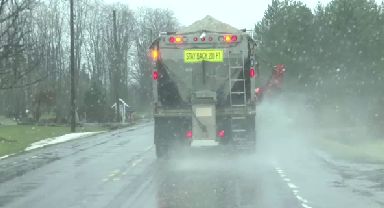Coming out of the holidays and into the threat of winter weather, the word “brine” takes on new meaning.
Brine trucks can start their runs as much as 48 hours before the onset of winter weather. So, what is putting brine on the roads all about?
What You Need To Know
- The purpose of brine is to reduce the freezing temperature of water
- It can be applied as much as 48 hours before a winter storm
- Less salt is used, so environmental impacts are reduced
- Using brine has pros and cons
Why do we put down brine or rock salt to begin with? It’s applied to lower the freezing point of water to keep ice from forming on the road surface.
In short, it is a proactive approach to prevent snow or ice from bonding to the road surface. A solution of brine will lower the freezing point of water from 32 degrees down to 18 degrees. The brine solution is 23.3% sodium chloride (NaCl, for those who remember high school chemistry), but can be made with calcium chloride or magnesium chloride.
With too little salt, the roads can still freeze. But if you add too much salt, crystallization occurs.
When crews put down rock salt, as much as 30% may end up bouncing off the road onto the shoulder or into the ditch, so brine is more effective because it coats the roadway better than plain salt.
It's also much more cost-effective. Brine costs somewhere around 15 cents per gallon to produce. You can treat one mile of a single-lane road for about $6. Rock salt costs about over $14 to treat the same mile. So there is less waste, and it is cheaper.
Using brine can be better for the environment than rock salt, as well. It means the use of less salt overall, which reduces the adverse impacts to soil, vegetation, streams and rivers.
So what's wrong with brine?
To begin with, it cannot be applied to a wet road. That means that, during a storm, brine is not an option. And brine is more corrosive to vehicles than bulk salt, so don’t drive right behind that truck when it’s spraying brine. Run your car through the car wash after the roads are clear.
Now here’s where it gets interesting. In some parts of the country, organics are added to the brine to take into account the particular storm conditions they expect to deal with.
By organics, we are talking about byproducts from cheese, sugar beets or similar ingredients. These organics are meant to increase the longevity of the brine on the pavement. There's also evidence that organics may also reduce the corrosion of vehicles.
Now, when you see those lines of dried brine on the roads, you’ll have a better understanding of the science behind it and why it is used to keep us safe during a winter storm.
Our team of meteorologists dives deep into the science of weather and breaks down timely weather data and information. To view more weather and climate stories, check out our weather blogs section.




